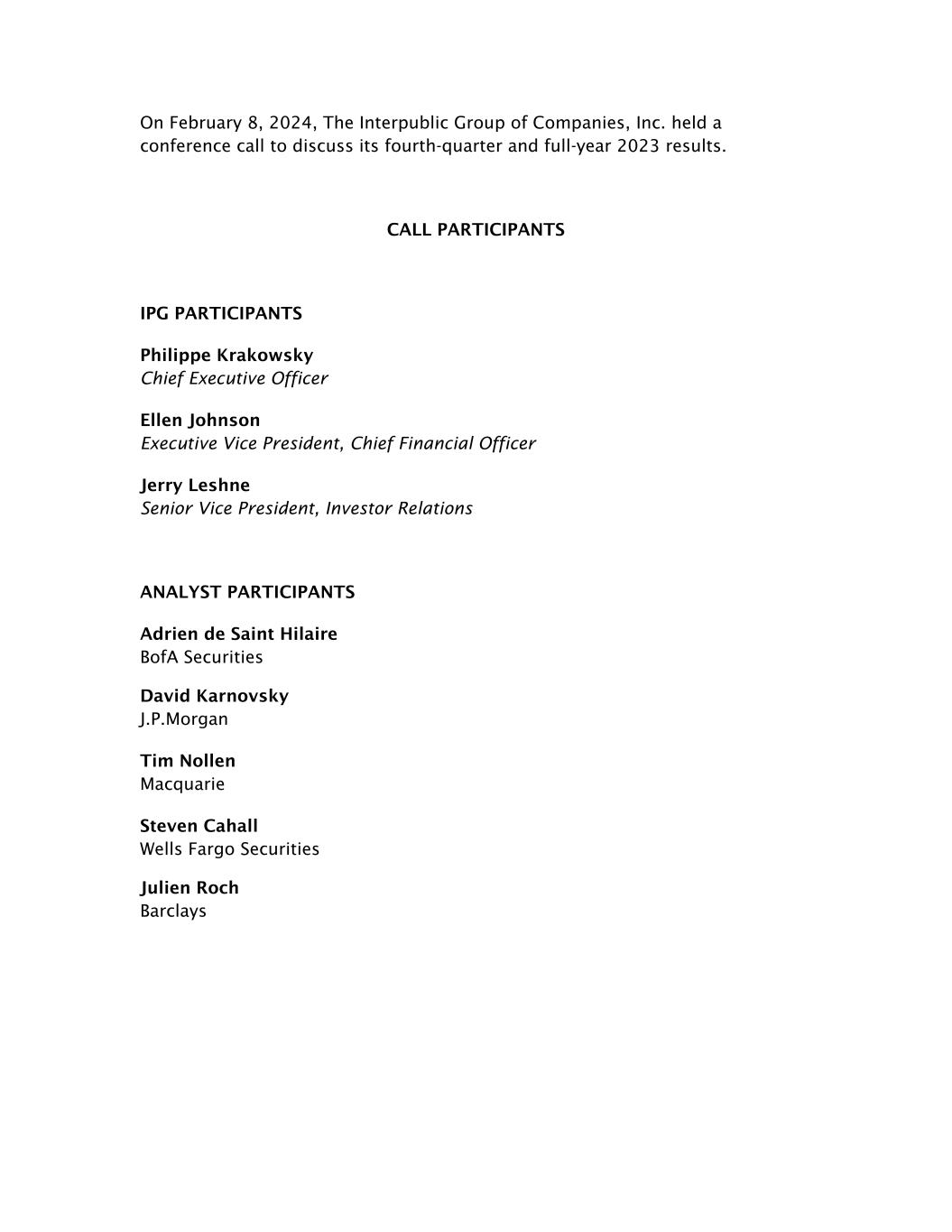
On February 8, 2024, The Interpublic Group of Companies, Inc. held a conference call to discuss its fourth-quarter and full-year 2023 results. CALL PARTICIPANTS IPG PARTICIPANTS Philippe Krakowsky Chief Executive Officer Ellen Johnson Executive Vice President, Chief Financial Officer Jerry Leshne Senior Vice President, Investor Relations ANALYST PARTICIPANTS Adrien de Saint Hilaire BofA Securities David Karnovsky J.P.Morgan Tim Nollen Macquarie Steven Cahall Wells Fargo Securities Julien Roch Barclays
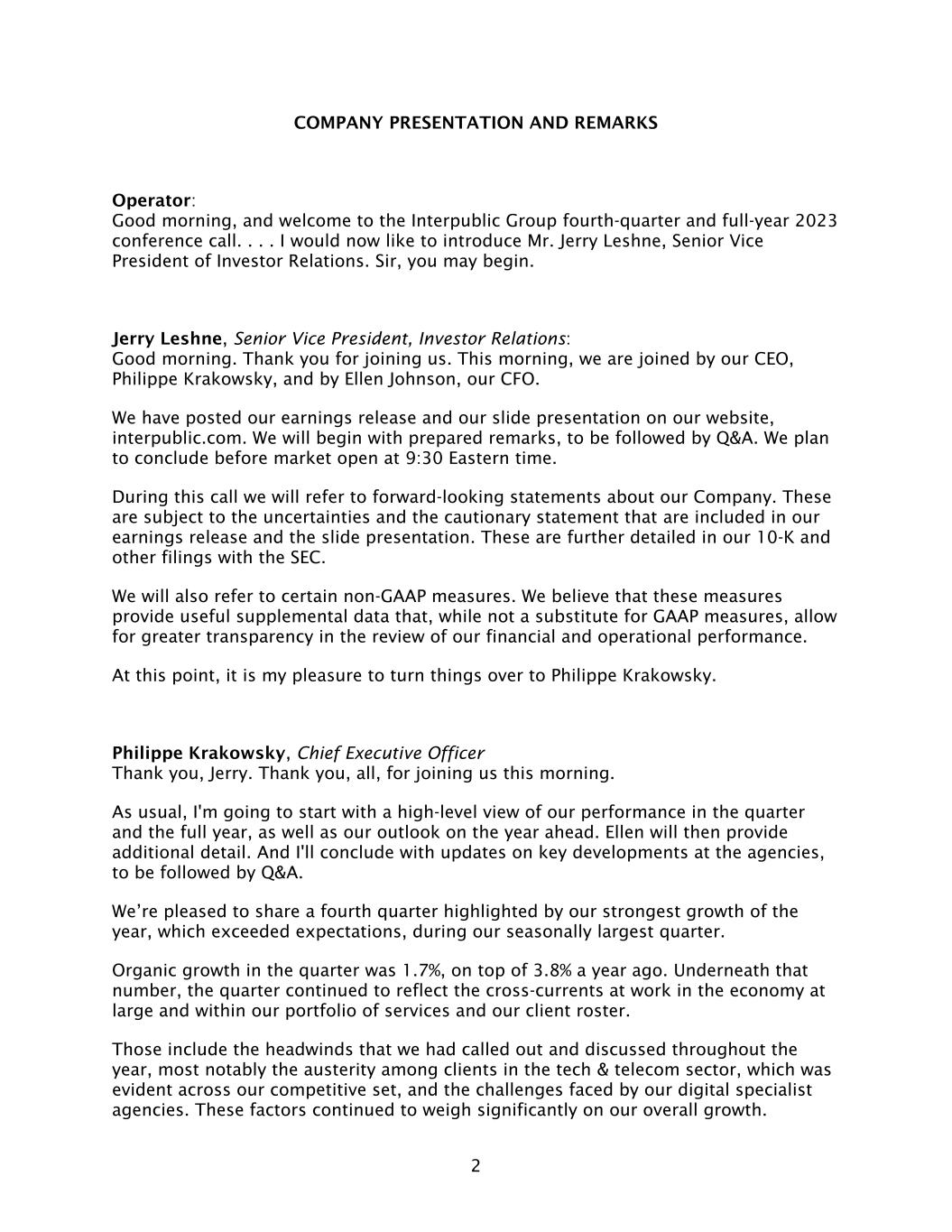
2 COMPANY PRESENTATION AND REMARKS Operator: Good morning, and welcome to the Interpublic Group fourth-quarter and full-year 2023 conference call. . . . I would now like to introduce Mr. Jerry Leshne, Senior Vice President of Investor Relations. Sir, you may begin. Jerry Leshne, Senior Vice President, Investor Relations: Good morning. Thank you for joining us. This morning, we are joined by our CEO, Philippe Krakowsky, and by Ellen Johnson, our CFO. We have posted our earnings release and our slide presentation on our website, interpublic.com. We will begin with prepared remarks, to be followed by Q&A. We plan to conclude before market open at 9:30 Eastern time. During this call we will refer to forward-looking statements about our Company. These are subject to the uncertainties and the cautionary statement that are included in our earnings release and the slide presentation. These are further detailed in our 10-K and other filings with the SEC. We will also refer to certain non-GAAP measures. We believe that these measures provide useful supplemental data that, while not a substitute for GAAP measures, allow for greater transparency in the review of our financial and operational performance. At this point, it is my pleasure to turn things over to Philippe Krakowsky. Philippe Krakowsky, Chief Executive Officer Thank you, Jerry. Thank you, all, for joining us this morning. As usual, I'm going to start with a high-level view of our performance in the quarter and the full year, as well as our outlook on the year ahead. Ellen will then provide additional detail. And I'll conclude with updates on key developments at the agencies, to be followed by Q&A. We’re pleased to share a fourth quarter highlighted by our strongest growth of the year, which exceeded expectations, during our seasonally largest quarter. Organic growth in the quarter was 1.7%, on top of 3.8% a year ago. Underneath that number, the quarter continued to reflect the cross-currents at work in the economy at large and within our portfolio of services and our client roster. Those include the headwinds that we had called out and discussed throughout the year, most notably the austerity among clients in the tech & telecom sector, which was evident across our competitive set, and the challenges faced by our digital specialist agencies. These factors continued to weigh significantly on our overall growth.
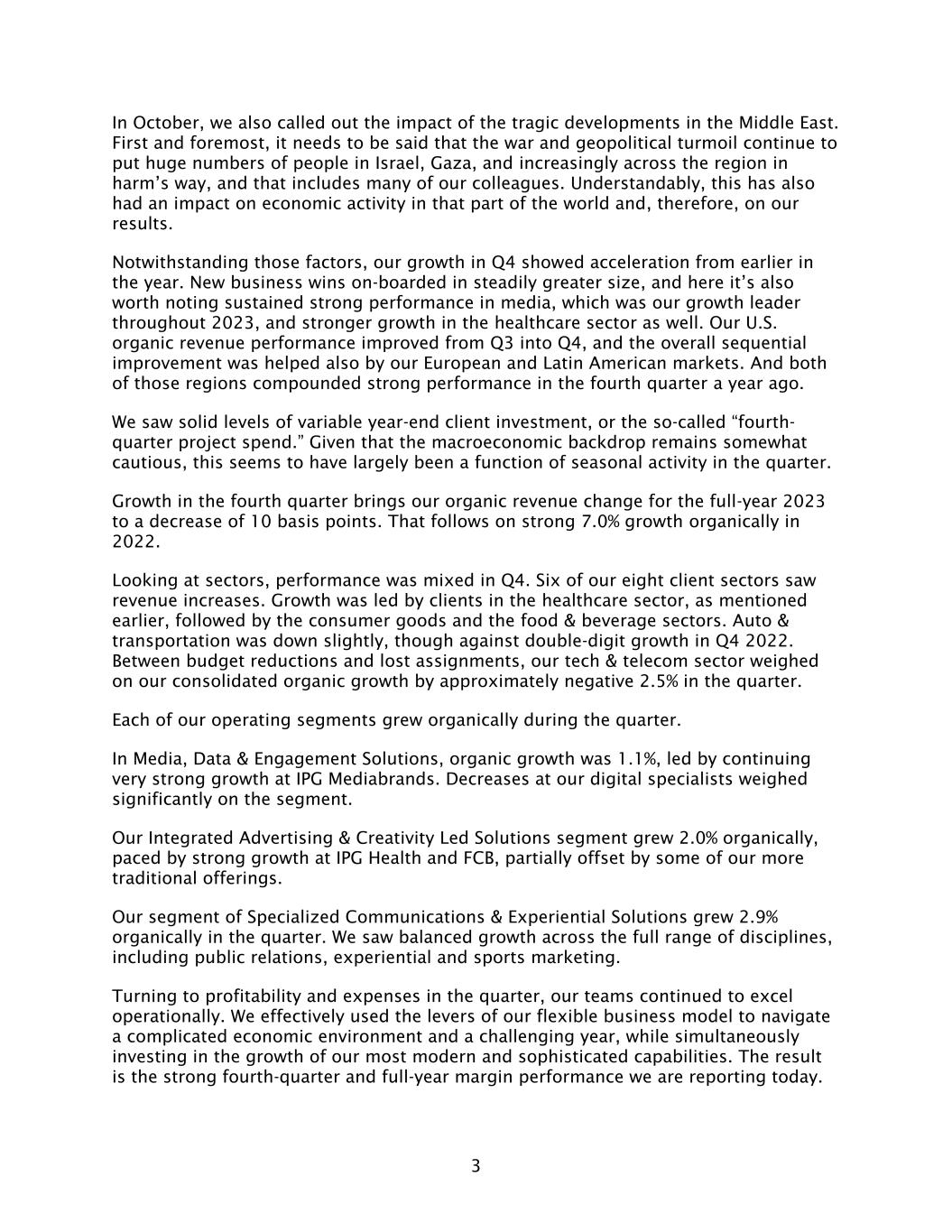
3 In October, we also called out the impact of the tragic developments in the Middle East. First and foremost, it needs to be said that the war and geopolitical turmoil continue to put huge numbers of people in Israel, Gaza, and increasingly across the region in harm’s way, and that includes many of our colleagues. Understandably, this has also had an impact on economic activity in that part of the world and, therefore, on our results. Notwithstanding those factors, our growth in Q4 showed acceleration from earlier in the year. New business wins on-boarded in steadily greater size, and here it’s also worth noting sustained strong performance in media, which was our growth leader throughout 2023, and stronger growth in the healthcare sector as well. Our U.S. organic revenue performance improved from Q3 into Q4, and the overall sequential improvement was helped also by our European and Latin American markets. And both of those regions compounded strong performance in the fourth quarter a year ago. We saw solid levels of variable year-end client investment, or the so-called “fourth- quarter project spend.” Given that the macroeconomic backdrop remains somewhat cautious, this seems to have largely been a function of seasonal activity in the quarter. Growth in the fourth quarter brings our organic revenue change for the full-year 2023 to a decrease of 10 basis points. That follows on strong 7.0% growth organically in 2022. Looking at sectors, performance was mixed in Q4. Six of our eight client sectors saw revenue increases. Growth was led by clients in the healthcare sector, as mentioned earlier, followed by the consumer goods and the food & beverage sectors. Auto & transportation was down slightly, though against double-digit growth in Q4 2022. Between budget reductions and lost assignments, our tech & telecom sector weighed on our consolidated organic growth by approximately negative 2.5% in the quarter. Each of our operating segments grew organically during the quarter. In Media, Data & Engagement Solutions, organic growth was 1.1%, led by continuing very strong growth at IPG Mediabrands. Decreases at our digital specialists weighed significantly on the segment. Our Integrated Advertising & Creativity Led Solutions segment grew 2.0% organically, paced by strong growth at IPG Health and FCB, partially offset by some of our more traditional offerings. Our segment of Specialized Communications & Experiential Solutions grew 2.9% organically in the quarter. We saw balanced growth across the full range of disciplines, including public relations, experiential and sports marketing. Turning to profitability and expenses in the quarter, our teams continued to excel operationally. We effectively used the levers of our flexible business model to navigate a complicated economic environment and a challenging year, while simultaneously investing in the growth of our most modern and sophisticated capabilities. The result is the strong fourth-quarter and full-year margin performance we are reporting today.

4 Adjusted EBITA margin on net revenue was 24.3% in the quarter, an increase of 200 basis points from a year ago. We drove operating leverage on our expense for base payroll, benefits & tax, our performance-based incentive compensation and our expense for occupancy. With that performance, our full-year margin was 16.7%, which delivers against the target we set at the beginning of 2023 and further consolidates significant margin improvement over the recent past. Fourth-quarter net income as reported was $463.2 million. Our adjusted EBITA was $628.5 million, an increase of 11% from a year ago. Fourth-quarter diluted earnings per share was $1.21 as reported, and $1.18 as adjusted for intangibles amortization and the non-operating impact of the disposition of small, nonstrategic businesses. Full-year adjusted diluted EPS was $2.99. And, as an important reminder, our EPS in the year’s second quarter, both as reported and adjusted, included the benefit of $0.17 per share related to the resolution of routine federal income tax audits of previous years, for which we did not adjust. During the quarter, our share repurchases totaled $131 million, which brought our share repurchases in 2023 to $350 million. Over the course of the year, total capital returns to shareholders, between dividends and share repurchases, were $829 million. As you’ve seen today, given the continued confidence of our Board in our operating strength and financial position, as well as our long-term strategic trajectory, we have once again raised IPG’s quarterly dividend, by 6%, to $0.33 per share. This marks our twelfth consecutive year of increased dividends. And our Board also authorized an additional $320 million of share repurchase, on top of the $80 million remaining on our previous authorization. Turning our discussion to 2024, we continue to see economic and geopolitical uncertainty inform many of our clients’ thinking. Despite signs that the consumer economy is improving, there remains a disparity of views regarding overall macro growth prospects. This is leading to some client conservatism, largely consistent with what we noted over much of the past year. We are seeing a measure of quarter-to-quarter stability in the tech & telco sector. As previously discussed, budget reductions at our major technology industry clients have been a consequence of broader enterprise cost-cutting programs within those companies. And while it’s still not possible to call the timing of a significant upturn in tech spending and marketing activity, we’ve noted a more recent stabilization in that spend. However, a return to growth for us in this sector has not been factored into our plan for 2024. With respect to our specialty digital offerings, we have taken several steps to strengthen their performance. This includes new leadership, co-location of global headquarters in a common innovation hub, as well as comprehensively lowering and aligning their operating cost base in line with revenue. We continue to focus on a broad range of strategic as well as market-facing solutions over the near-term, and that includes M&A to address the need for greater scale in digital transformation.

5 As we look ahead, we remain confident in the fundamental strengths of our Company. We are focused on building on our significant new business success in the past year, as well as on our longer-term record of growth. We also anticipate that the strongest and most consistent growth areas of our business, such as our data and tech-driven media offerings, healthcare marketing expertise, PR and experiential marketing capabilities, will continue to perform well in the year ahead. In addition, our proven operational discipline will stay in effect. The net of these moving parts, with certain areas of very strong performance within the portfolio, continued client caution, and a focus on addressing challenges in some of our legacy and digital specialists, leads us to an expected organic net revenue growth for 2024 in a range of 1% to 2%. At that level of growth, we expect 2024 full-year adjusted EBITA margin of 16.6%. This reflects a number of investments, including in further development of our contemporary addressable capabilities, such as the data-powered tools that inform and drive integration and decision-making across IPG, retail media, artificial intelligence, as well as building new buying models within Mediabrands. We will also continue to focus on streamlining operations and processes across the Group. We are confident that our investment in growth, combined with continued operational excellence on the part of our teams, means that our margins will resume their upward trajectory over the years ahead, consistent with our record in this area. In 2024, delivering on our goals, along with integrating our services in ways that help clients build their business and their brands, will be essential in creating value for all of our stakeholders. At this point, I’ll hand things over to Ellen for a more in-depth view on our results.
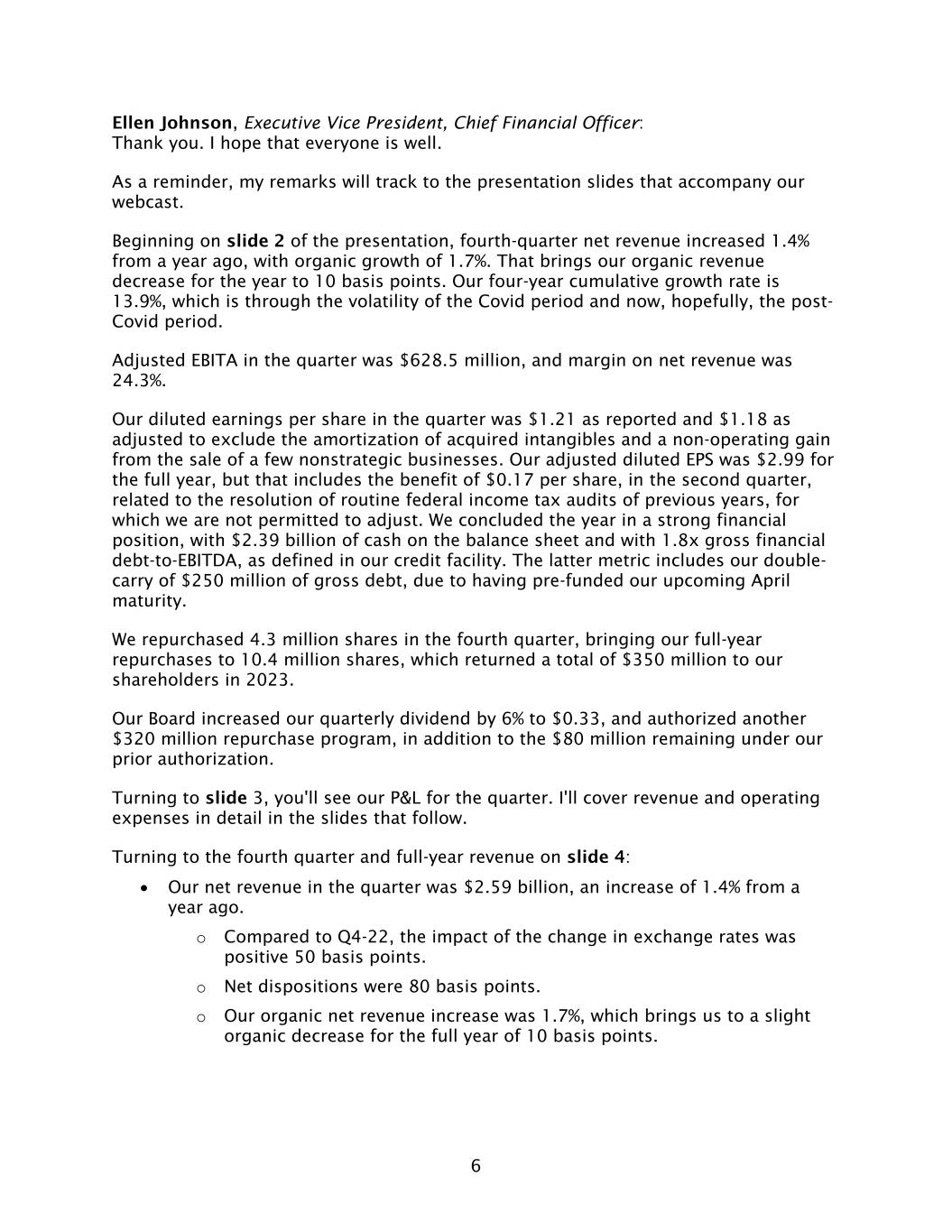
6 Ellen Johnson, Executive Vice President, Chief Financial Officer: Thank you. I hope that everyone is well. As a reminder, my remarks will track to the presentation slides that accompany our webcast. Beginning on slide 2 of the presentation, fourth-quarter net revenue increased 1.4% from a year ago, with organic growth of 1.7%. That brings our organic revenue decrease for the year to 10 basis points. Our four-year cumulative growth rate is 13.9%, which is through the volatility of the Covid period and now, hopefully, the post- Covid period. Adjusted EBITA in the quarter was $628.5 million, and margin on net revenue was 24.3%. Our diluted earnings per share in the quarter was $1.21 as reported and $1.18 as adjusted to exclude the amortization of acquired intangibles and a non-operating gain from the sale of a few nonstrategic businesses. Our adjusted diluted EPS was $2.99 for the full year, but that includes the benefit of $0.17 per share, in the second quarter, related to the resolution of routine federal income tax audits of previous years, for which we are not permitted to adjust. We concluded the year in a strong financial position, with $2.39 billion of cash on the balance sheet and with 1.8x gross financial debt-to-EBITDA, as defined in our credit facility. The latter metric includes our double- carry of $250 million of gross debt, due to having pre-funded our upcoming April maturity. We repurchased 4.3 million shares in the fourth quarter, bringing our full-year repurchases to 10.4 million shares, which returned a total of $350 million to our shareholders in 2023. Our Board increased our quarterly dividend by 6% to $0.33, and authorized another $320 million repurchase program, in addition to the $80 million remaining under our prior authorization. Turning to slide 3, you'll see our P&L for the quarter. I'll cover revenue and operating expenses in detail in the slides that follow. Turning to the fourth quarter and full-year revenue on slide 4: • Our net revenue in the quarter was $2.59 billion, an increase of 1.4% from a year ago. o Compared to Q4-22, the impact of the change in exchange rates was positive 50 basis points. o Net dispositions were 80 basis points. o Our organic net revenue increase was 1.7%, which brings us to a slight organic decrease for the full year of 10 basis points.

7 Further down this slide, we break out our segment net revenue performance: • Our Media, Data & Engagement Solutions segment grew 1.1% organically, on top of 5.2% in the fourth quarter of 2022. The quarter was driven by strong growth at IPG Mediabrands, on top of double-digit growth a year ago. Our challenges at our specialty digital agencies continued to significantly weigh on overall segment growth. The organic decrease of this segment was 10 basis points for the full year. • Organic growth at our Integrated Advertising & Creativity Led Solutions segment was 2.0%, which was on top of 2.2% a year ago. Our growth in the quarter was led by IPG Health and FCB, partially offset by some of our more traditional offerings. For the year, the segment decreased 1.7% organically, after 6.2% growth in 2022. • At our Specialized Communications & Experiential Solutions segment, organic growth was 2.9%, on top of 3.6% a year ago. We had growth across all major segment disciplines: public relations, experiential and sports marketing. For the year, the SC&E segment grew 4.1% organically, compounding 8.6% organic growth in 2022. Moving on to slide 5, our revenue growth by region in the quarter: • The U.S., which was 62% of our fourth-quarter net revenue, grew organically by 10 basis points. o We had notably strong growth at IPG Health, IPG Mediabrands, and FCB. o These increases, and others, were largely offset by decreases at our digital specialist agencies, and by the loss of a client in the telecom sector at McCann. In addition, the impact of macro uncertainty was felt broadly across our more traditional consumer-facing offerings. • International markets were 38% of our net revenue in the quarter and increased 4.3% organically, which is on top of 6.1% in the fourth quarter of 2022. o In the U.K., which was 8% of our net revenue in the quarter, organic growth was 40 basis points. We had very strong growth with clients in the automotive and retail sectors. Those increases were largely offset by decreased revenue in the tech & telecom and healthcare sectors. o Continental Europe was 10% of our net revenue in the quarter and grew 11.7% organically, on top of 5.7% a year ago. We grew across most national markets and had notably strong performances by IPG Mediabrands and McCann. We saw strong growth in the consumer, food & beverage and healthcare sectors. o In AsiaPac, which was 8% of net revenue, our organic decrease was 1.5%. While we had strong growth in India and Australia, that was more than offset by decreases in Japan and China. o In LatAm, we grew 15.0% organically in the quarter, on top of 5.8% a year ago. Our growth was across all major national markets, with notable strength in Mexico, Brazil and Argentina. LatAm was 6% of our net revenue in the quarter.
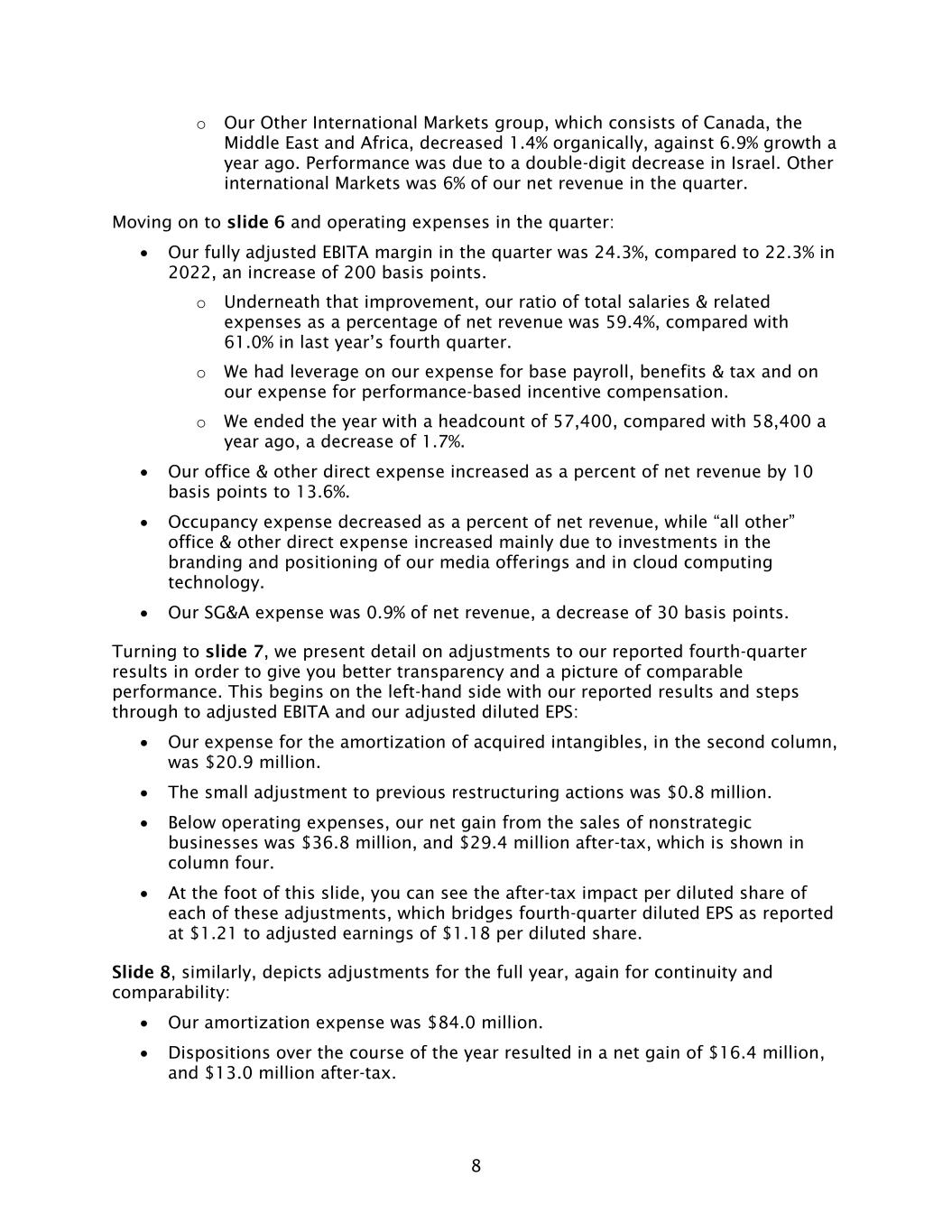
8 o Our Other International Markets group, which consists of Canada, the Middle East and Africa, decreased 1.4% organically, against 6.9% growth a year ago. Performance was due to a double-digit decrease in Israel. Other international Markets was 6% of our net revenue in the quarter. Moving on to slide 6 and operating expenses in the quarter: • Our fully adjusted EBITA margin in the quarter was 24.3%, compared to 22.3% in 2022, an increase of 200 basis points. o Underneath that improvement, our ratio of total salaries & related expenses as a percentage of net revenue was 59.4%, compared with 61.0% in last year’s fourth quarter. o We had leverage on our expense for base payroll, benefits & tax and on our expense for performance-based incentive compensation. o We ended the year with a headcount of 57,400, compared with 58,400 a year ago, a decrease of 1.7%. • Our office & other direct expense increased as a percent of net revenue by 10 basis points to 13.6%. • Occupancy expense decreased as a percent of net revenue, while “all other” office & other direct expense increased mainly due to investments in the branding and positioning of our media offerings and in cloud computing technology. • Our SG&A expense was 0.9% of net revenue, a decrease of 30 basis points. Turning to slide 7, we present detail on adjustments to our reported fourth-quarter results in order to give you better transparency and a picture of comparable performance. This begins on the left-hand side with our reported results and steps through to adjusted EBITA and our adjusted diluted EPS: • Our expense for the amortization of acquired intangibles, in the second column, was $20.9 million. • The small adjustment to previous restructuring actions was $0.8 million. • Below operating expenses, our net gain from the sales of nonstrategic businesses was $36.8 million, and $29.4 million after-tax, which is shown in column four. • At the foot of this slide, you can see the after-tax impact per diluted share of each of these adjustments, which bridges fourth-quarter diluted EPS as reported at $1.21 to adjusted earnings of $1.18 per diluted share. Slide 8, similarly, depicts adjustments for the full year, again for continuity and comparability: • Our amortization expense was $84.0 million. • Dispositions over the course of the year resulted in a net gain of $16.4 million, and $13.0 million after-tax.
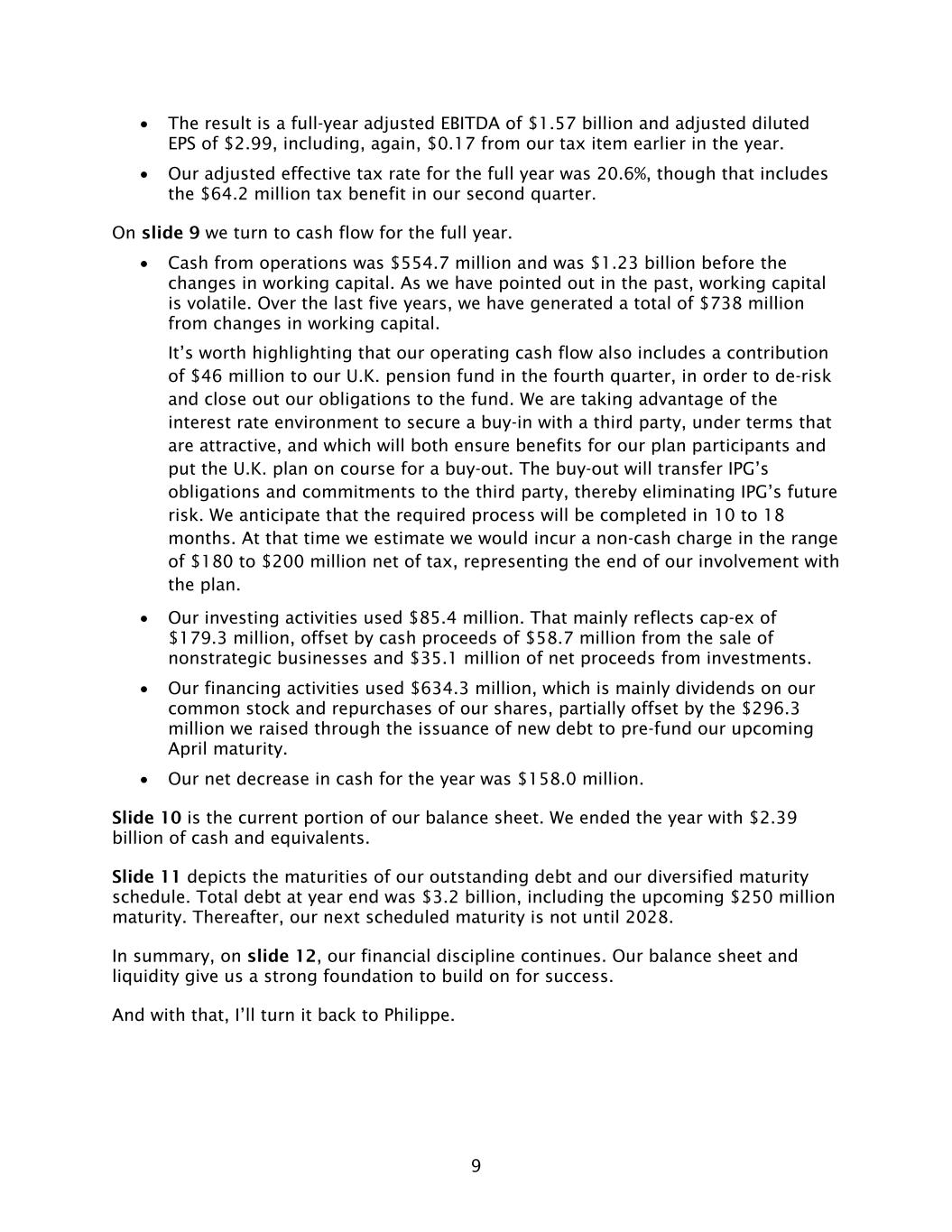
9 • The result is a full-year adjusted EBITDA of $1.57 billion and adjusted diluted EPS of $2.99, including, again, $0.17 from our tax item earlier in the year. • Our adjusted effective tax rate for the full year was 20.6%, though that includes the $64.2 million tax benefit in our second quarter. On slide 9 we turn to cash flow for the full year. • Cash from operations was $554.7 million and was $1.23 billion before the changes in working capital. As we have pointed out in the past, working capital is volatile. Over the last five years, we have generated a total of $738 million from changes in working capital. It’s worth highlighting that our operating cash flow also includes a contribution of $46 million to our U.K. pension fund in the fourth quarter, in order to de-risk and close out our obligations to the fund. We are taking advantage of the interest rate environment to secure a buy-in with a third party, under terms that are attractive, and which will both ensure benefits for our plan participants and put the U.K. plan on course for a buy-out. The buy-out will transfer IPG’s obligations and commitments to the third party, thereby eliminating IPG’s future risk. We anticipate that the required process will be completed in 10 to 18 months. At that time we estimate we would incur a non-cash charge in the range of $180 to $200 million net of tax, representing the end of our involvement with the plan. • Our investing activities used $85.4 million. That mainly reflects cap-ex of $179.3 million, offset by cash proceeds of $58.7 million from the sale of nonstrategic businesses and $35.1 million of net proceeds from investments. • Our financing activities used $634.3 million, which is mainly dividends on our common stock and repurchases of our shares, partially offset by the $296.3 million we raised through the issuance of new debt to pre-fund our upcoming April maturity. • Our net decrease in cash for the year was $158.0 million. Slide 10 is the current portion of our balance sheet. We ended the year with $2.39 billion of cash and equivalents. Slide 11 depicts the maturities of our outstanding debt and our diversified maturity schedule. Total debt at year end was $3.2 billion, including the upcoming $250 million maturity. Thereafter, our next scheduled maturity is not until 2028. In summary, on slide 12, our financial discipline continues. Our balance sheet and liquidity give us a strong foundation to build on for success. And with that, I’ll turn it back to Philippe.

10 Mr. Krakowsky: Thanks, Ellen. During the course of 2023, both our industry and our Company faced an elevated degree of volatility. And while the top line improved measurably through the fourth quarter, for the year we did not perform up to our expectations, or the standards we’ve set over the long term. We’ve covered the ins-and-outs of this performance as it relates to our asset and client mix. To address the needs of modern marketers, in recent years you’ve seen us create centralized skillsets and resources in areas such as audience definition and identity resolution, and, more recently, commerce and production. We are connecting more of our traditional offerings to these capabilities and, in order to activate these services fully across the Group, during 2023 we also brought in a number of key functional leaders at the corporate group level. Our strategy, talent and culture continue to drive innovation, creativity and integrated services, which come together in ways that help our clients succeed. Another key to our long-term growth has been our expertise in first-party data management and accountable marketing solutions. These continue to be areas of core relevance to marketers looking to build their brands and simultaneously deliver business outcomes in an increasingly digital economy. More recently, we have focused on four strategic areas to further our data and technology strategy. First is a suite of identity resolution tools, built by Acxiom, to help clients navigate a cookie-less world. Second, our unified retail media network solution at IPG Mediabrands, which ensures brands have a holistic view of their performance across the fast-growth ecosystem of retail platforms. This, in turn, integrates with our commerce offerings across the Company, which extend to all core marketing functions, whether that’s media, creative, experiential, or earned impressions and PR. And fourth, our investment in performance marketing at KINESSO, moving powerful addressable solutions closer to our end users, which is helping brands follow the movement of customers throughout their purchasing journey and then activate accordingly. Analytics teams, as well as modeling and decisioning tools, are core to all these efforts. These are also areas where we continue to make investments in artificial intelligence. It’s important to note that AI is not new: machine learning has been an ongoing part of our media and data business for many years. Combined with the latest advances in generative AI, we are now adding the same level of intelligence to the creation of personalized content across the marketing spectrum. We believe our current and prospective investment in AI continues to be at rates commensurate with competitors, relative to the scale of our respective organizations. IPG has enterprise-level agreements in place with a range of key AI vendors, including Amazon, Adobe, Microsoft, Google, Getty and OpenAI, as well as with innovative and emerging partners in the space.
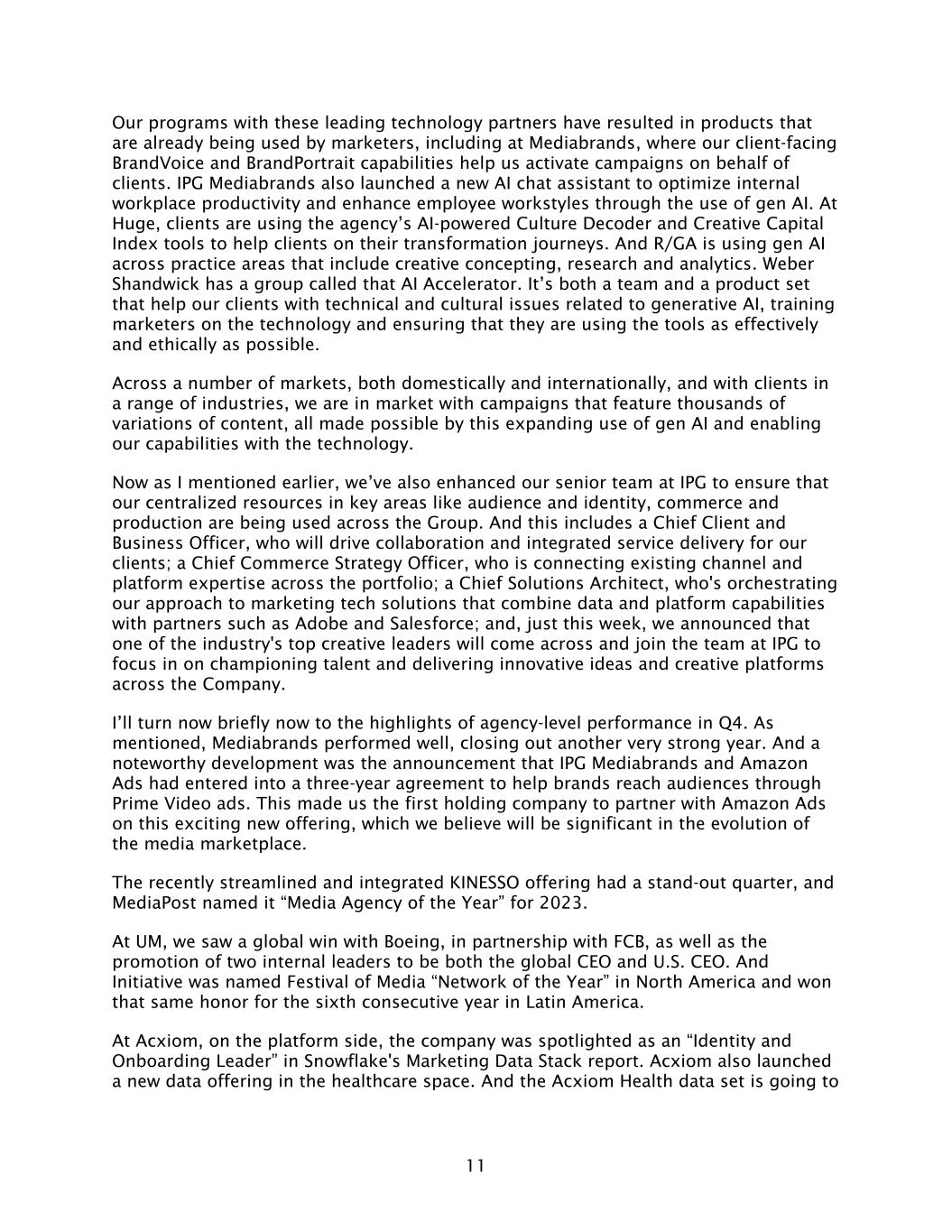
11 Our programs with these leading technology partners have resulted in products that are already being used by marketers, including at Mediabrands, where our client-facing BrandVoice and BrandPortrait capabilities help us activate campaigns on behalf of clients. IPG Mediabrands also launched a new AI chat assistant to optimize internal workplace productivity and enhance employee workstyles through the use of gen AI. At Huge, clients are using the agency’s AI-powered Culture Decoder and Creative Capital Index tools to help clients on their transformation journeys. And R/GA is using gen AI across practice areas that include creative concepting, research and analytics. Weber Shandwick has a group called that AI Accelerator. It’s both a team and a product set that help our clients with technical and cultural issues related to generative AI, training marketers on the technology and ensuring that they are using the tools as effectively and ethically as possible. Across a number of markets, both domestically and internationally, and with clients in a range of industries, we are in market with campaigns that feature thousands of variations of content, all made possible by this expanding use of gen AI and enabling our capabilities with the technology. Now as I mentioned earlier, we’ve also enhanced our senior team at IPG to ensure that our centralized resources in key areas like audience and identity, commerce and production are being used across the Group. And this includes a Chief Client and Business Officer, who will drive collaboration and integrated service delivery for our clients; a Chief Commerce Strategy Officer, who is connecting existing channel and platform expertise across the portfolio; a Chief Solutions Architect, who's orchestrating our approach to marketing tech solutions that combine data and platform capabilities with partners such as Adobe and Salesforce; and, just this week, we announced that one of the industry's top creative leaders will come across and join the team at IPG to focus in on championing talent and delivering innovative ideas and creative platforms across the Company. I’ll turn now briefly now to the highlights of agency-level performance in Q4. As mentioned, Mediabrands performed well, closing out another very strong year. And a noteworthy development was the announcement that IPG Mediabrands and Amazon Ads had entered into a three-year agreement to help brands reach audiences through Prime Video ads. This made us the first holding company to partner with Amazon Ads on this exciting new offering, which we believe will be significant in the evolution of the media marketplace. The recently streamlined and integrated KINESSO offering had a stand-out quarter, and MediaPost named it “Media Agency of the Year” for 2023. At UM, we saw a global win with Boeing, in partnership with FCB, as well as the promotion of two internal leaders to be both the global CEO and U.S. CEO. And Initiative was named Festival of Media “Network of the Year” in North America and won that same honor for the sixth consecutive year in Latin America. At Acxiom, on the platform side, the company was spotlighted as an “Identity and Onboarding Leader” in Snowflake's Marketing Data Stack report. Acxiom also launched a new data offering in the healthcare space. And the Acxiom Health data set is going to

12 enable our healthcare clients to significantly increase campaign conversions and improve the success of display and video advertising. As we’ve mentioned, IPG Health had a strong quarter, leveraging tailwinds from both new business wins and its longstanding leadership in the category. In terms of industry recognition, the unit dominated at the Medical Marketing and Media Awards, being named “Network of the Year” for the second consecutive year. FCB's performance was strong, as it has been consistently over the course of 2023. Clorox consolidated all of its U.S. creative duties with the agency during Q4. And at year end, the network continued to garner top industry accolades creatively, with “Global Network of the Year” honors at The One Show and similar honors for its North America operations. At our earned and experiential agencies, Momentum Worldwide became the first agency to secure AI patents that fuse machine-learning and AI to create smarter and more targeted experiences for consumers. Octagon brought on a range of new clients in the fourth quarter, notably Subway, as well as significantly expanding its work with clients such as Snickers and the Premier League. Our PR networks showed solid growth during the quarter; we saw this across geographies. The healthcare sector was a strong contributor, driven by a key AOR appointment at Walgreens and a new assignment with existing client Vertex. Weber won AOR duties for Eventbrite, and also created the biggest earned media campaign ever on the part of Kellanova, one of our important clients, as part of their college football bowl sponsorship. And Golin was appointed to lead Fidelity’s U.S. PR efforts, including external newsroom operations, earned media relations, crisis management, as well as content measurement. On the ESG front, we announced our inclusion on three key corporate ratings: the Dow Jones Sustainability Index for North America, the Human Rights Campaign’s Corporate Equality Index and a “Best Place to Work” on the Disability Equality Index. We see earning recognition from these leading organizations as further validation of our own efforts to create a fair and inclusive culture across the organization. Stepping back, I think we know that the world in which we live is increasingly digital and that more than ever clients need help from us in using audience-led thinking powered by data and AI to solve for a widening set of business problems and opportunities. As always, we’re going to continue to invest behind the growth of businesses by developing our own people and continuing to differentiate our offerings. This includes investment in upskilling, training and recruitment, particularly around AI, but also marketing platforms and cloud-computing. Our plans also include a disciplined approach to M&A, which will focus on opportunities that are consistent with strategic growth areas, notably, increasing our scale and capabilities in digital transformation and our total commerce offerings.
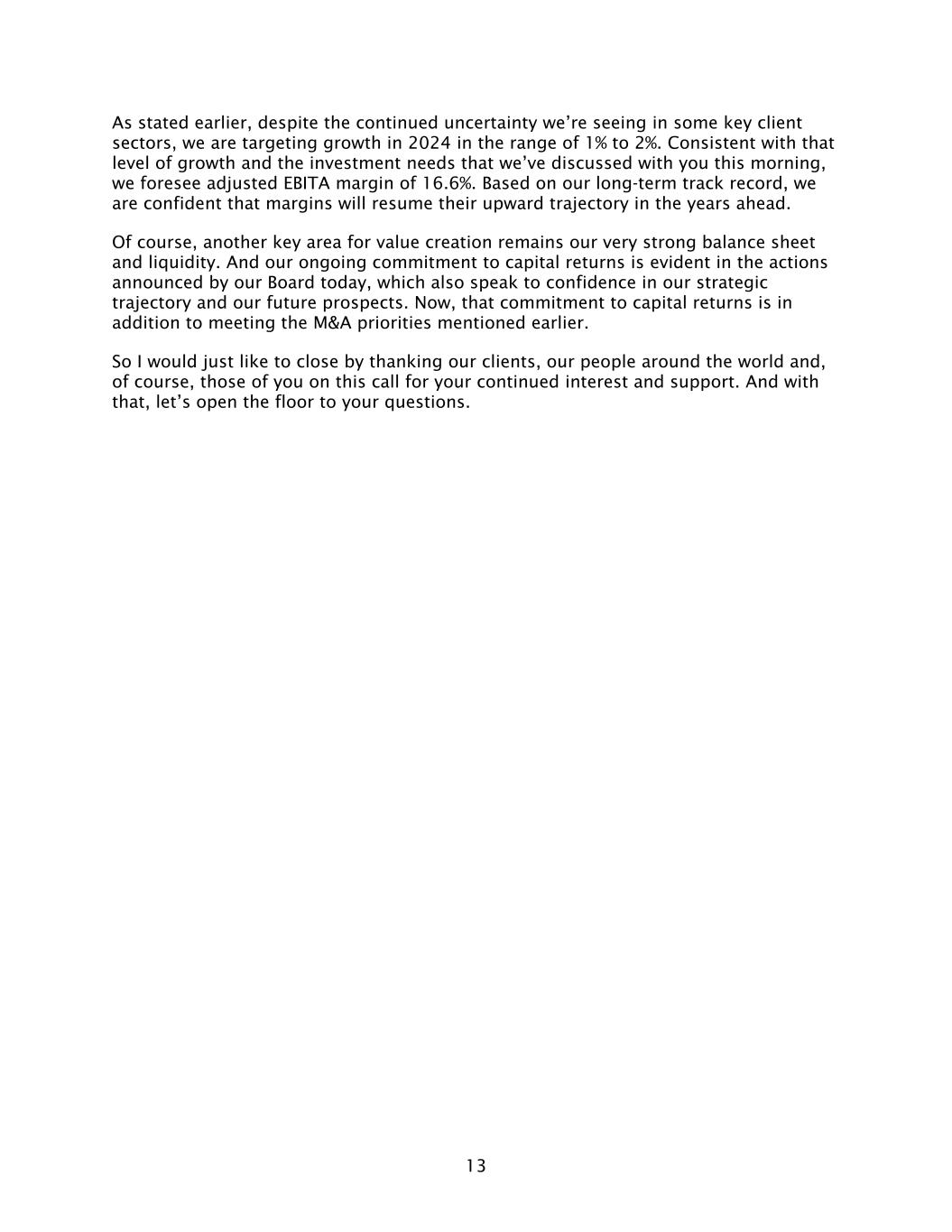
13 As stated earlier, despite the continued uncertainty we’re seeing in some key client sectors, we are targeting growth in 2024 in the range of 1% to 2%. Consistent with that level of growth and the investment needs that we’ve discussed with you this morning, we foresee adjusted EBITA margin of 16.6%. Based on our long-term track record, we are confident that margins will resume their upward trajectory in the years ahead. Of course, another key area for value creation remains our very strong balance sheet and liquidity. And our ongoing commitment to capital returns is evident in the actions announced by our Board today, which also speak to confidence in our strategic trajectory and our future prospects. Now, that commitment to capital returns is in addition to meeting the M&A priorities mentioned earlier. So I would just like to close by thanking our clients, our people around the world and, of course, those of you on this call for your continued interest and support. And with that, let’s open the floor to your questions.

14 QUESTIONS AND ANSWERS Operator: . . . . Our first question is from Adrien de Saint Hilaire with Bank of America. You may go ahead. Adrien de Saint Hilaire, BofA Securities: Yes, good morning, everyone. Thanks for taking those questions. I’ve got a couple if you don’t mind. First of all, Philippe and Ellen, can you help us with the cadence of growth that you expect for 2024? Some of your competitors have been talking about Q1 being in line with the full year. Some others have talked about the year being more second-half weighted. Where do you shake out? And the second question is, what impact from net new business are you assuming in the 1% to 2%? Because on the one hand, you flagged some decent success of course with GEICO, Pfizer. But then you have some other accounts which are under review, like Amazon, and some others, like GM, which may be under review. So, curious if you’ve assumed any benefits or any loss or something neutral in there. Thank you very much. Philippe Krakowsky, Chief Executive Officer: Adrien, thank you for the question. You know, what I’ll try to do is just unpack and give you the component parts of that 1% to 2%. I think I would see two ways to consider it. Whether you think, you know, mix and/or balance of assets in the Group. So, relative size of maybe some of the most traditional, those more traditional, assets. We’ve talked about the impact that the digital agencies, though a small part of revenue, are having to our overall growth. But what we’ve factored into our thinking was strong continued performance from segments of the portfolio that have either more precision or more accountability or technical expertise baked in. So clearly, media: long a leader, accretive top and bottom-line. Healthcare. And then, marketing services like experiential and earned for any number of reasons, I think, are very relevant and making an impact with clients, given how hard it is to connect with consumers. We factored in the expectation that tech & telco will continue to pressure growth, less so than last year, and that, as we said, stabilization broadly speaking among that client set. But for us, clearly, we’re carrying a sizable loss in telco that will be felt through most of the year. On the digital specialists, I think the plan has similar expectations. They do lean more heavily into the tech space. But, as I also mentioned, I think we’re thinking a lot about whether we’ve got the scale there that we require, specifically around skill sets like digital transformation. So, not likely positive, but less of a drag than last year. And then, with respect to new business, as you said, we had quite a number of large wins, some of which we began to feel the benefit of in the back half of last year and more so in Q4. Regrettably, we then had two sizable losses: different flavors, different reasons behind that. But we’re going to basically be carrying the headwinds of both

15 those losses all year this year. So if we think about new business as we head into the year, for the totality of ’23, that’s taken a lot of the wind out of our sails. So we figure we’re, broadly speaking, flat. And those are all the moving parts. I mean I don’t know that, Ellen, if there’s anything to add. We don’t usually walk folks through the phasing of the quarter, but that, hopefully, that is point by point all of the ways that we got to how we see ’24 and what informs that range that we’re guiding to. Ellen Johnson, Executive Vice President, Chief Financial Officer: Very comprehensive. Mr. de Saint Hilaire: No, thank you, Philippe. Very clear Operator: Thank you. Our next question is from David Karnovsky with JPMorgan. You may go ahead. David Karnovsky, J.P.Morgan: Hi, thanks. Maybe to follow-up on the prior one: Philippe, you noted stabilization broadly for tech — Philippe Krakowsky, Chief Executive Officer: There’s only been one. You say you’re following-up on a prior question; you’re the second question. Mr. Karnovsky: Well, I’ll follow-up on the first part of the prior question. [Laughter] So you noted a stabilization, broadly, for tech & telecom, outside of the new business impact. I just wanted to see if you could expand on what you’re seeing in the vertical right now. Are there any kind of renewed indications of project work or brand spend? And then, on margins, you know in the past, you’ve spoken to the Company’s ability to expand profitability in almost any environment. And I think we can appreciate there are unique factors in ’24, like incentives resetting or investment in certain areas, but I wanted to get you to speak a little bit longer-term, and would you expect to continue to convert organic growth into margin gains as you have in the past? Thanks. Mr. Krakowsky: Absolutely. Well, look. I don’t think any of us is — you know the way in which we demonstrated in ’23 that you can run a business of this scale and this complexity and see margin improvement notwithstanding no growth is not our — you know, any number of us have talked about it over time. And we’ve always said that the flexible cost model does give us the ability to do that.

16 Looking forward, I think that we tried to call out for you where we see the need for and — we’re pretty specific about areas where there’ll be organic investment in the business. And I think that’s part of why we’re essentially in a sort of flattish/down 10 basis points in terms of where the margin target is. But nothing has changed that in the underlying: with growth we convert to improvement in margin. And then, as you know as well, there is the degree to which we’re going to continue to think about and look at our own processes and re-engineering our business. AI will actually play a part in that as well. And it’s not a ’24 event, but the additional dimension to our media offerings, so, media buying model: that kind of adds the ability to take that principle to generate efficiency. Because I think we’ve been a media buyer where value has been about effectiveness, I think there’ll be opportunity there. So I would not conclude that this year is indicative. I think we tried to be as clear as we could in the prepared remarks that we still see upside on the margin. And the first part of your question, I don’t — again, I think what we shared in the past is that it did feel to us as if during the fourth quarter tech & telco was stabilizing, and I would say that that’s still the case. It doesn’t feel like we’re seeing meaningful upside there. And to Adrien’s question, we have not factored that into our thinking for ’24. Mr. Karnovsky: Okay. Thank you. Mr. Krakowsky: Thank you. Operator: Thank you. The next question is from Tim Nollen with Macquarie. You may go ahead. Tim Nollen, Macquarie: Hey, thanks very much. Philippe, I’d just like to ask about some of the reorganization that you’ve done. You’ve had some management turnover, you’ve had some account losses. But I’m focused actually on the data and media segment. And you mentioned KINESSO in your prepared remarks. Just wondering if you could help us understand how that data and media organization is more simplified, how it presumably should be better, can help clients drive better returns on spending, hopefully win some more business. And, relatedly, I think you mentioned, also in your prepared remarks, about focusing some M&A activity on scale and digital transformation activities. I wonder if that’s a particular call-out or just — and if there’s anything more to add to that, or if this is just kind of a standard thing that you’d be investing in?
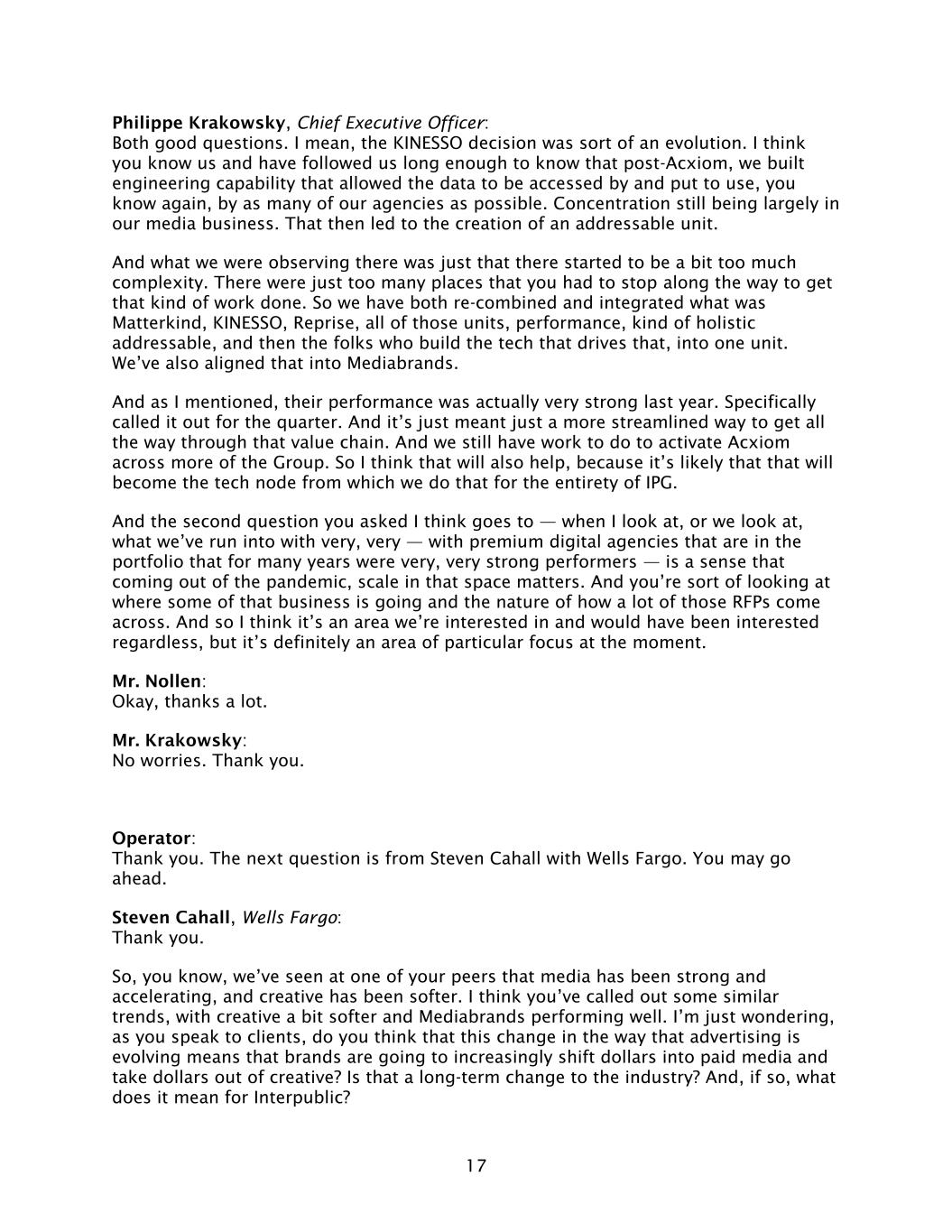
17 Philippe Krakowsky, Chief Executive Officer: Both good questions. I mean, the KINESSO decision was sort of an evolution. I think you know us and have followed us long enough to know that post-Acxiom, we built engineering capability that allowed the data to be accessed by and put to use, you know again, by as many of our agencies as possible. Concentration still being largely in our media business. That then led to the creation of an addressable unit. And what we were observing there was just that there started to be a bit too much complexity. There were just too many places that you had to stop along the way to get that kind of work done. So we have both re-combined and integrated what was Matterkind, KINESSO, Reprise, all of those units, performance, kind of holistic addressable, and then the folks who build the tech that drives that, into one unit. We’ve also aligned that into Mediabrands. And as I mentioned, their performance was actually very strong last year. Specifically called it out for the quarter. And it’s just meant just a more streamlined way to get all the way through that value chain. And we still have work to do to activate Acxiom across more of the Group. So I think that will also help, because it’s likely that that will become the tech node from which we do that for the entirety of IPG. And the second question you asked I think goes to — when I look at, or we look at, what we’ve run into with very, very — with premium digital agencies that are in the portfolio that for many years were very, very strong performers — is a sense that coming out of the pandemic, scale in that space matters. And you’re sort of looking at where some of that business is going and the nature of how a lot of those RFPs come across. And so I think it’s an area we’re interested in and would have been interested regardless, but it’s definitely an area of particular focus at the moment. Mr. Nollen: Okay, thanks a lot. Mr. Krakowsky: No worries. Thank you. Operator: Thank you. The next question is from Steven Cahall with Wells Fargo. You may go ahead. Steven Cahall, Wells Fargo: Thank you. So, you know, we’ve seen at one of your peers that media has been strong and accelerating, and creative has been softer. I think you’ve called out some similar trends, with creative a bit softer and Mediabrands performing well. I’m just wondering, as you speak to clients, do you think that this change in the way that advertising is evolving means that brands are going to increasingly shift dollars into paid media and take dollars out of creative? Is that a long-term change to the industry? And, if so, what does it mean for Interpublic?
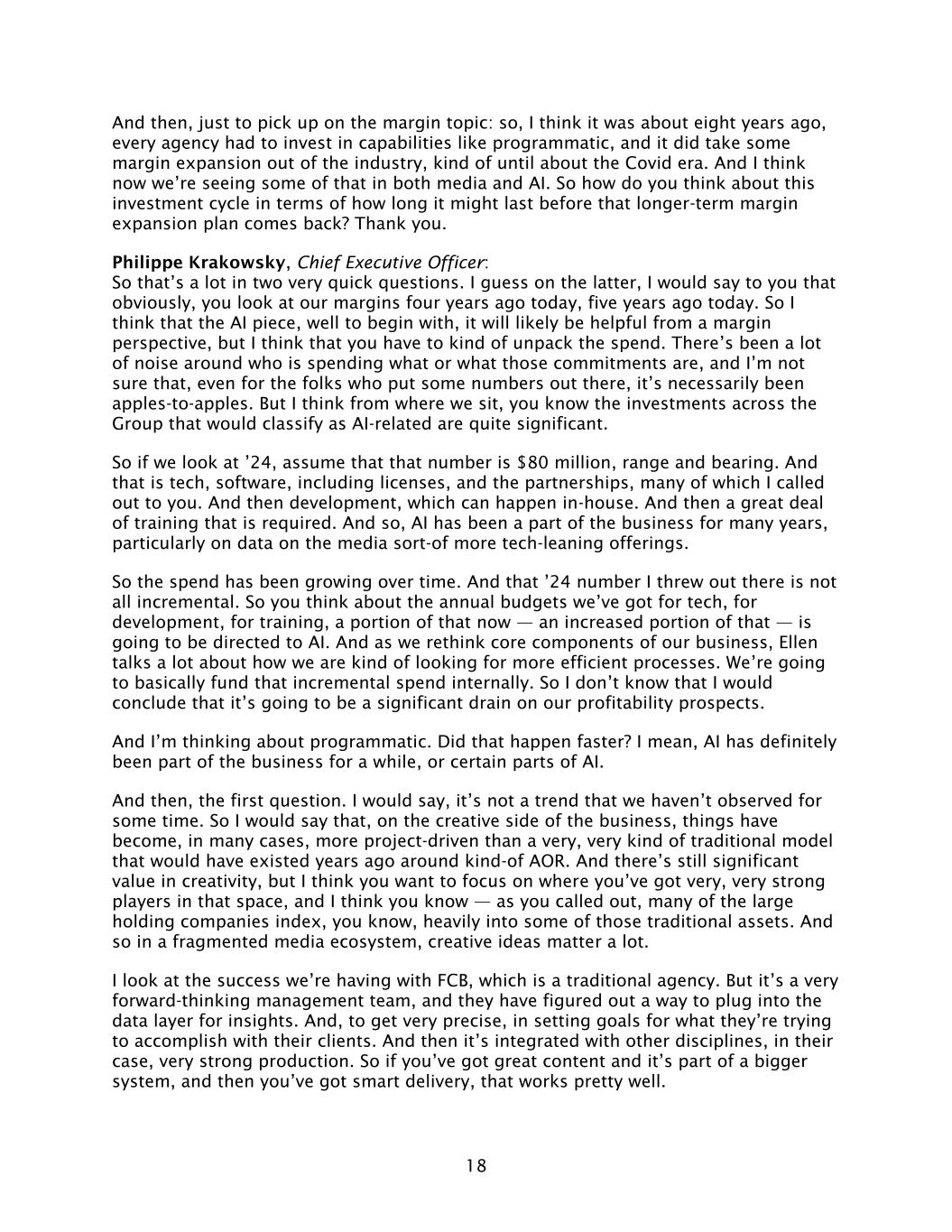
18 And then, just to pick up on the margin topic: so, I think it was about eight years ago, every agency had to invest in capabilities like programmatic, and it did take some margin expansion out of the industry, kind of until about the Covid era. And I think now we’re seeing some of that in both media and AI. So how do you think about this investment cycle in terms of how long it might last before that longer-term margin expansion plan comes back? Thank you. Philippe Krakowsky, Chief Executive Officer: So that’s a lot in two very quick questions. I guess on the latter, I would say to you that obviously, you look at our margins four years ago today, five years ago today. So I think that the AI piece, well to begin with, it will likely be helpful from a margin perspective, but I think that you have to kind of unpack the spend. There’s been a lot of noise around who is spending what or what those commitments are, and I’m not sure that, even for the folks who put some numbers out there, it’s necessarily been apples-to-apples. But I think from where we sit, you know the investments across the Group that would classify as AI-related are quite significant. So if we look at ’24, assume that that number is $80 million, range and bearing. And that is tech, software, including licenses, and the partnerships, many of which I called out to you. And then development, which can happen in-house. And then a great deal of training that is required. And so, AI has been a part of the business for many years, particularly on data on the media sort-of more tech-leaning offerings. So the spend has been growing over time. And that ’24 number I threw out there is not all incremental. So you think about the annual budgets we’ve got for tech, for development, for training, a portion of that now — an increased portion of that — is going to be directed to AI. And as we rethink core components of our business, Ellen talks a lot about how we are kind of looking for more efficient processes. We’re going to basically fund that incremental spend internally. So I don’t know that I would conclude that it’s going to be a significant drain on our profitability prospects. And I’m thinking about programmatic. Did that happen faster? I mean, AI has definitely been part of the business for a while, or certain parts of AI. And then, the first question. I would say, it’s not a trend that we haven’t observed for some time. So I would say that, on the creative side of the business, things have become, in many cases, more project-driven than a very, very kind of traditional model that would have existed years ago around kind-of AOR. And there’s still significant value in creativity, but I think you want to focus on where you’ve got very, very strong players in that space, and I think you know — as you called out, many of the large holding companies index, you know, heavily into some of those traditional assets. And so in a fragmented media ecosystem, creative ideas matter a lot. I look at the success we’re having with FCB, which is a traditional agency. But it’s a very forward-thinking management team, and they have figured out a way to plug into the data layer for insights. And, to get very precise, in setting goals for what they’re trying to accomplish with their clients. And then it’s integrated with other disciplines, in their case, very strong production. So if you’ve got great content and it’s part of a bigger system, and then you’ve got smart delivery, that works pretty well.
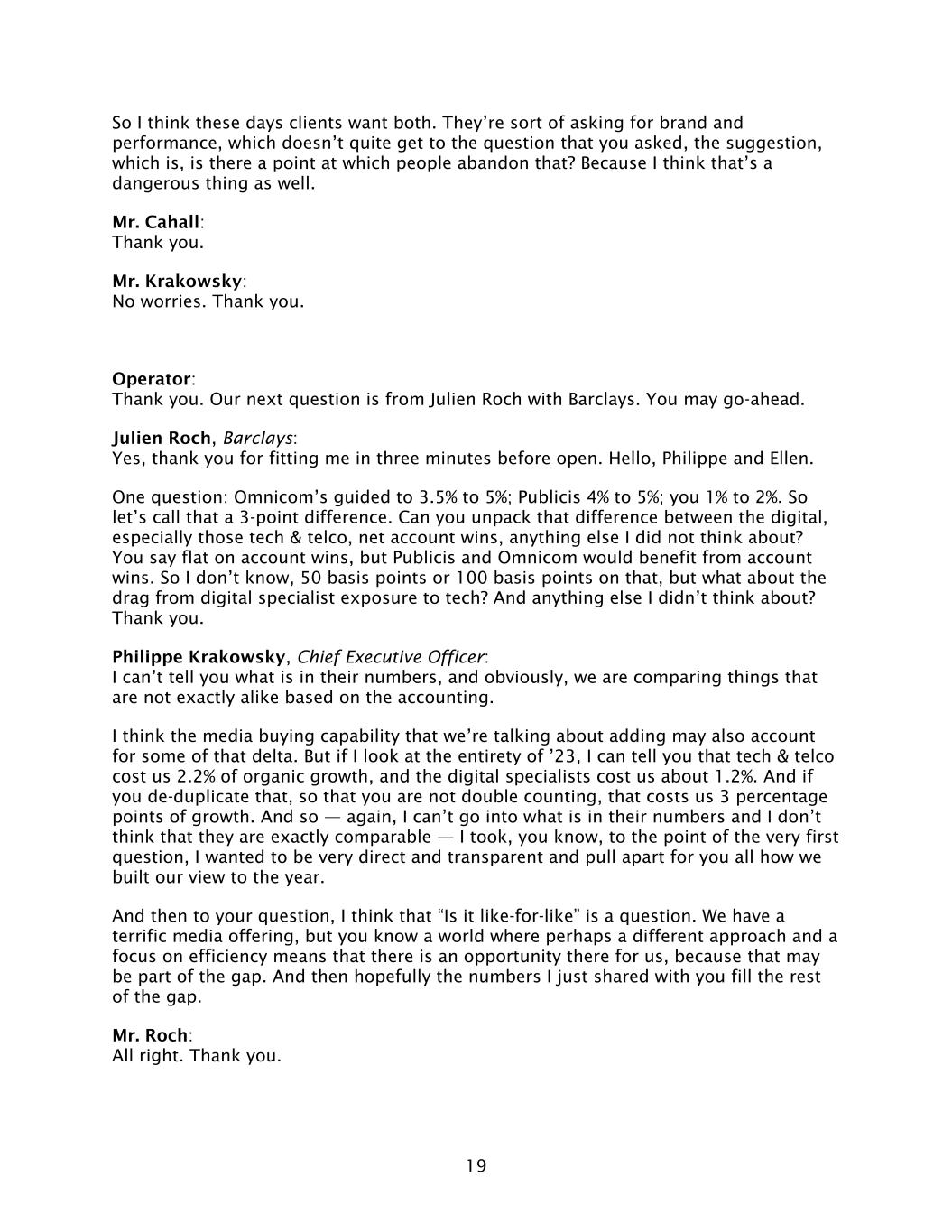
19 So I think these days clients want both. They’re sort of asking for brand and performance, which doesn’t quite get to the question that you asked, the suggestion, which is, is there a point at which people abandon that? Because I think that’s a dangerous thing as well. Mr. Cahall: Thank you. Mr. Krakowsky: No worries. Thank you. Operator: Thank you. Our next question is from Julien Roch with Barclays. You may go-ahead. Julien Roch, Barclays: Yes, thank you for fitting me in three minutes before open. Hello, Philippe and Ellen. One question: Omnicom’s guided to 3.5% to 5%; Publicis 4% to 5%; you 1% to 2%. So let’s call that a 3-point difference. Can you unpack that difference between the digital, especially those tech & telco, net account wins, anything else I did not think about? You say flat on account wins, but Publicis and Omnicom would benefit from account wins. So I don’t know, 50 basis points or 100 basis points on that, but what about the drag from digital specialist exposure to tech? And anything else I didn’t think about? Thank you. Philippe Krakowsky, Chief Executive Officer: I can’t tell you what is in their numbers, and obviously, we are comparing things that are not exactly alike based on the accounting. I think the media buying capability that we’re talking about adding may also account for some of that delta. But if I look at the entirety of ’23, I can tell you that tech & telco cost us 2.2% of organic growth, and the digital specialists cost us about 1.2%. And if you de-duplicate that, so that you are not double counting, that costs us 3 percentage points of growth. And so — again, I can’t go into what is in their numbers and I don’t think that they are exactly comparable — I took, you know, to the point of the very first question, I wanted to be very direct and transparent and pull apart for you all how we built our view to the year. And then to your question, I think that “Is it like-for-like” is a question. We have a terrific media offering, but you know a world where perhaps a different approach and a focus on efficiency means that there is an opportunity there for us, because that may be part of the gap. And then hopefully the numbers I just shared with you fill the rest of the gap. Mr. Roch: All right. Thank you.

20 Mr. Krakowsky: Thank you. Operator: Thank you. And that was our last question. I’ll now turn it back to Philippe for any final thoughts. Philippe Krakowsky, Chief Executive Officer: Well, thank you. Well, thank you, Sue. Thank you all for your time, and we will stay focused on the work that needs to get done here because, you know, to the point of a number of the questions, we definitely have to get back to things that have been the norm for us for a long time. And I think this is going to be a year where we can finish some of the transformations that are required to do that. So, appreciate the interest and the time. Operator: Thank you. And this concludes today’s conference. You may disconnect at this time.

21 Cautionary Statement This transcript contains forward-looking statements. Statements in this transcript that are not historical facts, including statements regarding goals, intentions and expectations as to future plans, trends, events, or future results of operations or financial position, constitute forward- looking statements. Without limiting the generality of the foregoing, words such as “may,” “will,” “expect,” “believe,” “anticipate,” “estimate,” “project,” “forecast,” “plan,” “intend,” “could,” “would,” “should,” “estimate,” “will likely result” or comparable terminology are intended to identify forward-looking statements. Forward-looking statements are based on current expectations and assumptions that are subject to risks and uncertainties, which could cause our actual results and outcomes to differ materially from those reflected in the forward-looking statements. Actual results and outcomes could differ materially for a variety of reasons, including, among others: • the effects of a challenging economy on the demand for our advertising and marketing services, on our clients’ financial condition and on our business or financial condition; • our ability to attract new clients and retain existing clients; • our ability to retain and attract key employees; • risks associated with the effects of global, national and regional economic and political conditions, including counterparty risks and fluctuations in interest rates, inflation rates and currency exchange rates; • the economic or business impact of military or political conflict; • the impacts on our business of any pandemics, epidemics, disease outbreaks or other public health crises; • risks associated with assumptions we make in connection with our critical accounting estimates, including changes in assumptions associated with any effects of a challenging economy; • potential adverse effects if we are required to recognize impairment charges or other adverse accounting-related developments; • developments from changes in the regulatory and legal environment for advertising and marketing services companies around the world, including laws and regulations related to data protection and consumer privacy; and • the impact on our operations of general or directed cybersecurity events. Investors should carefully consider the foregoing factors and the other risks and uncertainties that may affect our business, including those outlined under Item 1A, Risk Factors, in our most recent Annual Report on Form 10-K and our other SEC filings. Investors are cautioned not to place undue reliance on forward-looking statements, which speak only as of the date they are made. We undertake no obligation to update or revise publicly any of them in light of new information, future events, or otherwise.
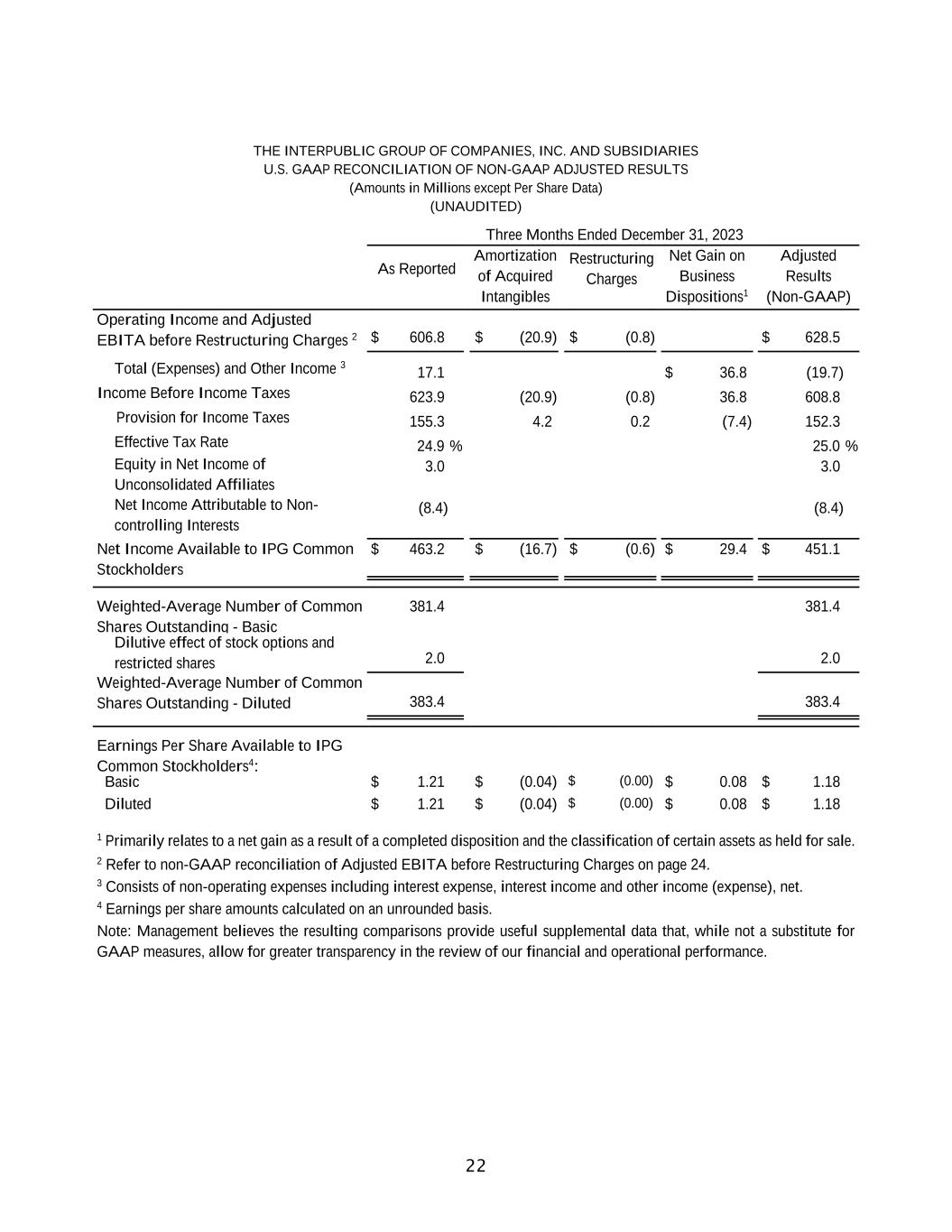
22 THE INTERPUBLIC GROUP OF COMPANIES, INC. AND SUBSIDIARIES U.S. GAAP RECONCILIATION OF NON-GAAP ADJUSTED RESULTS (Amounts in Millions except Per Share Data) (UNAUDITED) Three Months Ended December 31, 2023 As Reported Amortization of Acquired Intangibles Restructuring Charges Net Gain on Business Dispositions1 Adjusted Results (Non-GAAP) Operating Income and Adjusted EBITA before Restructuring Charges 2 $ 606.8 $ (20.9) $ (0.8) $ 628.5 Total (Expenses) and Other Income 3 17.1 $ 36.8 (19.7) Income Before Income Taxes 623.9 (20.9) (0.8) 36.8 608.8 Provision for Income Taxes 155.3 4.2 0.2 (7.4) 152.3 Effective Tax Rate 24.9 % 25.0 % Equity in Net Income of Unconsolidated Affiliates 3.0 3.0 Net Income Attributable to Non- controlling Interests (8.4) (8.4) Net Income Available to IPG Common Stockholders $ 463.2 $ (16.7) $ (0.6) $ 29.4 $ 451.1 Weighted-Average Number of Common Shares Outstanding - Basic 381.4 381.4 Dilutive effect of stock options and restricted shares 2.0 2.0 Weighted-Average Number of Common Shares Outstanding - Diluted 383.4 383.4 Earnings Per Share Available to IPG Common Stockholders4: Basic $ 1.21 $ (0.04) $ (0.00) $ 0.08 $ 1.18 Diluted $ 1.21 $ (0.04) $ (0.00) $ 0.08 $ 1.18 1 Primarily relates to a net gain as a result of a completed disposition and the classification of certain assets as held for sale. 2 Refer to non-GAAP reconciliation of Adjusted EBITA before Restructuring Charges on page 24. 3 Consists of non-operating expenses including interest expense, interest income and other income (expense), net. 4 Earnings per share amounts calculated on an unrounded basis. Note: Management believes the resulting comparisons provide useful supplemental data that, while not a substitute for GAAP measures, allow for greater transparency in the review of our financial and operational performance.
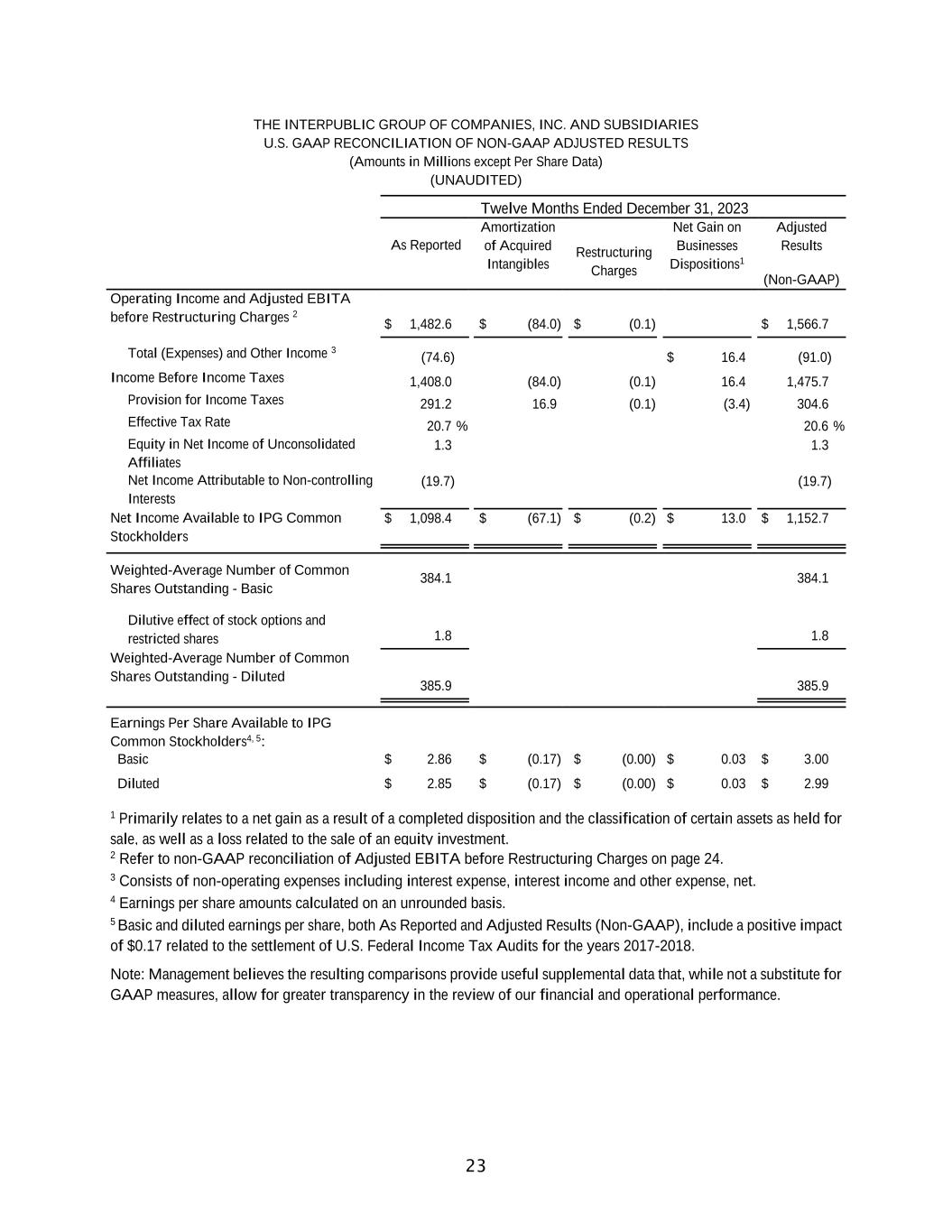
23 THE INTERPUBLIC GROUP OF COMPANIES, INC. AND SUBSIDIARIES U.S. GAAP RECONCILIATION OF NON-GAAP ADJUSTED RESULTS (Amounts in Millions except Per Share Data) (UNAUDITED) Twelve Months Ended December 31, 2023 As Reported Amortization of Acquired Intangibles Restructuring Charges Net Gain on Businesses Dispositions1 Adjusted Results (Non-GAAP) Operating Income and Adjusted EBITA before Restructuring Charges 2 $ 1,482.6 $ (84.0) $ (0.1) $ 1,566.7 Total (Expenses) and Other Income 3 (74.6) $ 16.4 (91.0) Income Before Income Taxes 1,408.0 (84.0) (0.1) 16.4 1,475.7 Provision for Income Taxes 291.2 16.9 (0.1) (3.4) 304.6 Effective Tax Rate 20.7 % 20.6 % Equity in Net Income of Unconsolidated Affiliates 1.3 1.3 Net Income Attributable to Non-controlling Interests (19.7) (19.7) Net Income Available to IPG Common Stockholders $ 1,098.4 $ (67.1) $ (0.2) $ 13.0 $ 1,152.7 Weighted-Average Number of Common Shares Outstanding - Basic 384.1 384.1 Dilutive effect of stock options and restricted shares 1.8 1.8 Weighted-Average Number of Common Shares Outstanding - Diluted 385.9 385.9 Earnings Per Share Available to IPG Common Stockholders4, 5: Basic $ 2.86 $ (0.17) $ (0.00) $ 0.03 $ 3.00 Diluted $ 2.85 $ (0.17) $ (0.00) $ 0.03 $ 2.99 1 Primarily relates to a net gain as a result of a completed disposition and the classification of certain assets as held for sale, as well as a loss related to the sale of an equity investment. 2 Refer to non-GAAP reconciliation of Adjusted EBITA before Restructuring Charges on page 24. 3 Consists of non-operating expenses including interest expense, interest income and other expense, net. 4 Earnings per share amounts calculated on an unrounded basis. 5 Basic and diluted earnings per share, both As Reported and Adjusted Results (Non-GAAP), include a positive impact of $0.17 related to the settlement of U.S. Federal Income Tax Audits for the years 2017-2018. Note: Management believes the resulting comparisons provide useful supplemental data that, while not a substitute for GAAP measures, allow for greater transparency in the review of our financial and operational performance.
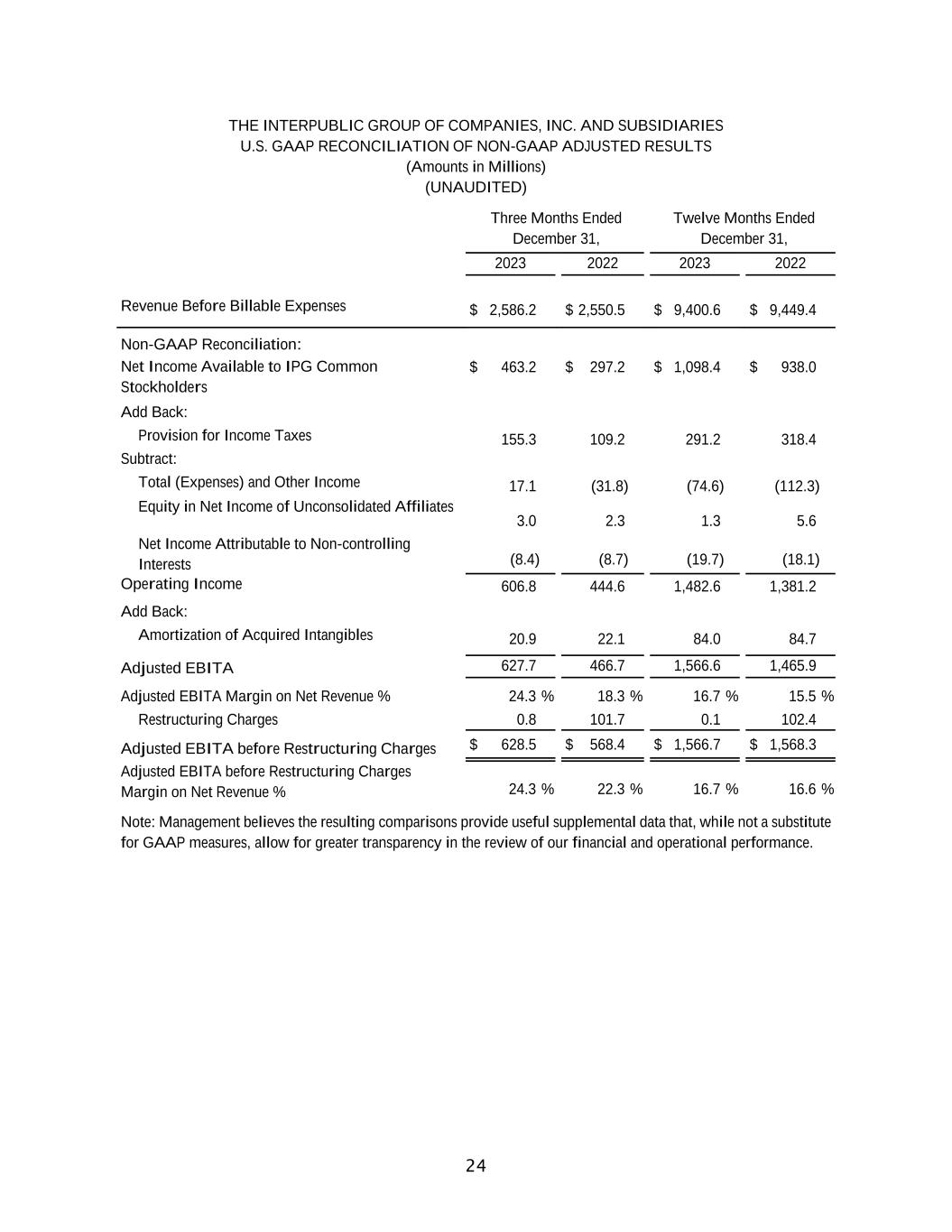
24 THE INTERPUBLIC GROUP OF COMPANIES, INC. AND SUBSIDIARIES U.S. GAAP RECONCILIATION OF NON-GAAP ADJUSTED RESULTS (Amounts in Millions) (UNAUDITED) Three Months Ended December 31, Twelve Months Ended December 31, 2023 2022 2023 2022 Revenue Before Billable Expenses $ 2,586.2 $ 2,550.5 $ 9,400.6 $ 9,449.4 Non-GAAP Reconciliation: Net Income Available to IPG Common Stockholders $ 463.2 $ 297.2 $ 1,098.4 $ 938.0 Add Back: Provision for Income Taxes 155.3 109.2 291.2 318.4 Subtract: Total (Expenses) and Other Income 17.1 (31.8) (74.6) (112.3) Equity in Net Income of Unconsolidated Affiliates 3.0 2.3 1.3 5.6 Net Income Attributable to Non-controlling Interests (8.4) (8.7) (19.7) (18.1) Operating Income 606.8 444.6 1,482.6 1,381.2 Add Back: Amortization of Acquired Intangibles 20.9 22.1 84.0 84.7 Adjusted EBITA 627.7 466.7 1,566.6 1,465.9 Adjusted EBITA Margin on Net Revenue % 24.3 % 18.3 % 16.7 % 15.5 % Restructuring Charges 0.8 101.7 0.1 102.4 Adjusted EBITA before Restructuring Charges $ 628.5 $ 568.4 $ 1,566.7 $ 1,568.3 Adjusted EBITA before Restructuring Charges Margin on Net Revenue % 24.3 % 22.3 % 16.7 % 16.6 % Note: Management believes the resulting comparisons provide useful supplemental data that, while not a substitute for GAAP measures, allow for greater transparency in the review of our financial and operational performance.
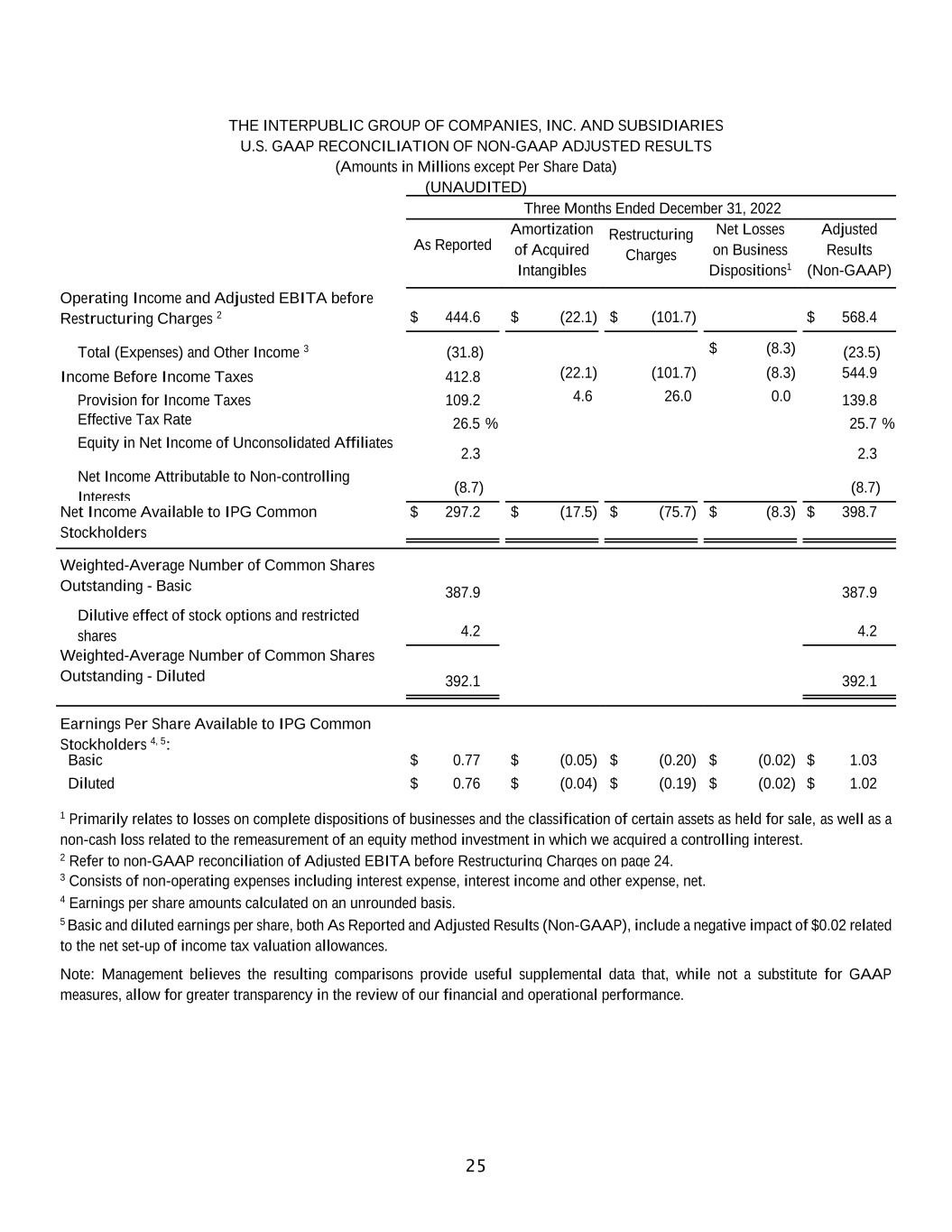
25 THE INTERPUBLIC GROUP OF COMPANIES, INC. AND SUBSIDIARIES U.S. GAAP RECONCILIATION OF NON-GAAP ADJUSTED RESULTS (Amounts in Millions except Per Share Data) (UNAUDITED) Three Months Ended December 31, 2022 As Reported Amortization of Acquired Intangibles Restructuring Charges Net Losses on Business Dispositions1 Adjusted Results (Non-GAAP) Operating Income and Adjusted EBITA before Restructuring Charges 2 $ 444.6 $ (22.1) $ (101.7) $ 568.4 Total (Expenses) and Other Income 3 (31.8) $ (8.3) (23.5) Income Before Income Taxes 412.8 (22.1) (101.7) (8.3) 544.9 Provision for Income Taxes 109.2 4.6 26.0 0.0 139.8 Effective Tax Rate 26.5 % 25.7 % Equity in Net Income of Unconsolidated Affiliates 2.3 2.3 Net Income Attributable to Non-controlling Interests (8.7) (8.7) Net Income Available to IPG Common Stockholders $ 297.2 $ (17.5) $ (75.7) $ (8.3) $ 398.7 Weighted-Average Number of Common Shares Outstanding - Basic 387.9 387.9 Dilutive effect of stock options and restricted shares 4.2 4.2 Weighted-Average Number of Common Shares Outstanding - Diluted 392.1 392.1 Earnings Per Share Available to IPG Common Stockholders 4, 5: Basic $ 0.77 $ (0.05) $ (0.20) $ (0.02) $ 1.03 Diluted $ 0.76 $ (0.04) $ (0.19) $ (0.02) $ 1.02 1 Primarily relates to losses on complete dispositions of businesses and the classification of certain assets as held for sale, as well as a non-cash loss related to the remeasurement of an equity method investment in which we acquired a controlling interest. 2 Refer to non-GAAP reconciliation of Adjusted EBITA before Restructuring Charges on page 24. 3 Consists of non-operating expenses including interest expense, interest income and other expense, net. 4 Earnings per share amounts calculated on an unrounded basis. 5 Basic and diluted earnings per share, both As Reported and Adjusted Results (Non-GAAP), include a negative impact of $0.02 related to the net set-up of income tax valuation allowances. Note: Management believes the resulting comparisons provide useful supplemental data that, while not a substitute for GAAP measures, allow for greater transparency in the review of our financial and operational performance.

26 THE INTERPUBLIC GROUP OF COMPANIES, INC. AND SUBSIDIARIES U.S. GAAP RECONCILIATION OF NON-GAAP ADJUSTED RESULTS (Amounts in Millions except Per Share Data) (UNAUDITED) Twelve Months Ended December 31, 2022 As Reported Amortization of Acquired Intangibles Restructuring Charges Net Losses on Business Dispositions1 Adjusted Results (Non-GAAP) Operating Income and Adjusted EBITA before Restructuring Charges 2 $ 1,381.2 $ (84.7) $ (102.4) $ 1,568.3 Total (Expenses) and Other Income 3 (112.3) $ (3.8) (108.5) Income Before Income Taxes 1,268.9 (84.7) (102.4) (3.8) 1,459.8 Provision for Income Taxes 318.4 17.3 25.8 0.1 361.6 Effective Tax Rate 25.1 % 24.8 % Equity in Net Income of Unconsolidated Affiliates 5.6 5.6 Net Income Attributable to Noncontrolling Interests (18.1) (18.1) Net Income Available to IPG Common Stockholders $ 938.0 $ (67.4) $ (76.6) $ (3.7) $ 1,085.7 Weighted-Average Number of Common Shares Outstanding - Basic 391.5 391.5 Dilutive effect of stock options and restricted shares 3.6 3.6 Weighted-Average Number of Common Shares Outstanding - Diluted 395.1 395.1 Earnings Per Share Available to IPG Common Stockholders 4, 5: Basic $ 2.40 $ (0.17) $ (0.20) $ (0.01) $ 2.77 Diluted $ 2.37 $ (0.17) $ (0.19) $ (0.01) $ 2.75 1 Includes a cash gain related to the sale of an equity investment, offset by losses on complete dispositions of businesses and the classification of certain assets as held for sale, a non-cash loss related to the deconsolidation of a previously consolidated subsidiary in which we maintain an equity interest, and a non-cash loss related to remeasurement of an equity method investment in which we acquired a controlling interest. 2 Refer to non-GAAP reconciliation of Adjusted EBITA before Restructuring Charges on page 24. 3 Consists of non-operating expenses including interest expense, interest income and other expense, net. 4 Earnings per share amounts calculated on an unrounded basis. 5 Basic and diluted earnings per share, both As Reported and Adjusted Results (Non-GAAP), include a negative impact of $0.02 related to the net set-up of income tax valuation allowances. Note: Management believes the resulting comparisons provide useful supplemental data that, while not a substitute for GAAP measures, allow for greater transparency in the review of our financial and operational performance.